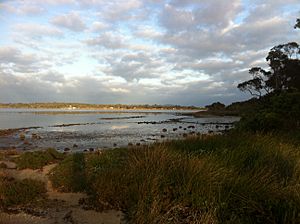Albany Fish Traps facts for kids
The Albany Fish Traps, also known as the Oyster Harbour Fish Traps, are very old structures found in Oyster Harbour. This special place is near the mouth of the Kalgan River, about 14 kilometres (9 miles) east of Albany in Western Australia. These amazing traps show how Aboriginal people lived and hunted long ago.
Contents
Who Built the Albany Fish Traps?
The fish traps were built by the Menang people, who are the traditional owners of this land. These traps are incredibly old, more than 7,500 years old! The area where the traps are located is very important and sacred to the Menang people. It was once a place for corroborees, which are special gatherings and ceremonies. People mostly used this area during the warmer months of the year.
How Did the Fish Traps Work?
The fish traps are made of low walls of loose stones. You can find them on the northern shore of Oyster Harbour, with a steep hill behind them. The Menang people used these walls to catch fish. As the tide came in, fish would swim over the low stone walls. When the tide went out, the fish would be trapped inside the areas created by the stones. The Menang people would then collect the fish at low tide. Sometimes, they would add brush or branches on top of the stone walls to make the traps even more effective.
What Do the Fish Traps Look Like?
The Albany Fish Traps are shaped like a crescent moon. They are made up of eight separate sections, called weirs. Each weir contains thousands of stones. The entire area of the traps covers about 800 square metres (8,611 square feet). When archaeologists studied just a small 1-metre (3-foot) section, they found about 80 stones used there.
When Can You See the Traps?
You can only see the fish traps when the tide is low. When the tide is high, they are covered by water. Many explorers from long ago described these traps. George Vancouver saw them in 1791. Nicolas Baudin wrote about them during his trip in 1803. Philip Parker King also described them in 1818. All the stones used to build the traps are dark, almost black. They are made of a natural rock called laterite, which is found on the shoreline.
Protecting the Ancient Site
The Albany Fish Traps are a very important historical and cultural site. In 1966, the site was given to the National Trust to help protect it. It was one of the first places to be declared a Protected Area under the Aboriginal Heritage Act 1972 when that law was passed in 1973.
Returning the Land to Its Owners
From 2000 to 2006, archaeologists carried out some small studies at the site. This was done at the request of the Menang people, the traditional owners. In 2009, the site was officially returned to the Menang people. This happened through a special ceremony with the Albany Heritage Reference Group Aboriginal Corporation.
Recent Efforts to Preserve the Traps
In 2011, people discovered that hundreds of the stones from the traps had been removed. To help protect the site and teach visitors about its history, a project was started. This project cost 170,000 Australian dollars. It included building a cultural shelter, a boardwalk for visitors, and signs to explain the traps. This important project was finished and opened in 2015.



